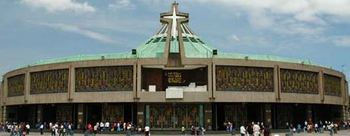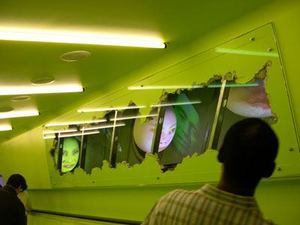The Virgin of Guadalupe lives in a mega church and also on flesh, walls, T-shirts, fenders, jewelry, key chains, postcards and sculptural replicas. Because I spent a good portion of my childhood in Southern California, I love this figure for where she’s been, for her experience, not her purity.
Via.
Besides the emblem of a conversion of a nation by means of flowers and a painting, the image is a viewer finder. Look in her eyes to see Juan Diego, her first convert, gazing at red flowers falling from her blue cloak.
The painting that was once housed here, a lovely church that continues to sink into the ground, hangs in the architectural monstrosity below. The sight of this Star Wars’ spaceship does not deter those who crawl on bloodied knees across a wide plaza to enter it.
 Inside for the first time, anyone hoping to get a good look at what passes for the only artwork painted by God is disappointed. The church is cavernous, the painting small. Even in the front pews, it’s far away.
Inside for the first time, anyone hoping to get a good look at what passes for the only artwork painted by God is disappointed. The church is cavernous, the painting small. Even in the front pews, it’s far away.
Fear not. Between the altar and the painting are two moving sidewalks. Ushers separate the crowds into opposing streams, both of which can peer up for a fast, pseudo-intimate look.The day I was there, in the late 1980s, I was awed by what appeared to be the sorting mechanism: Tourists on one side, faithful on the other.
How did the ushers know? The devout were not limited to locals or those clutching rosary beads, nor were the secular entirely tourist-like. Invited (forced) into the tourist stream, I’ve been wondering about it since. It’s my personal mystery of Guadalupe, a scan for belief that found me lacking.
Friends who were with me that day say I imagined the whole thing, that the differences between the two groups were accidental and of-the-moment. They’re wrong. Wherever they look, they see the secular and nothing else. They don’t wander between worlds, attracted to both and not quite at home in either.
Back to the part that cannot be disputed, the moving sidewalk. Usually, art stands still, and people pass it by. Like the moving sidewalks of the Guadalupe church, Tony Oursler intensified the equation, but for different reasons.
His talking heads gather to gripe behind a hole ripped into the wall in the middle of an escalator in the Seattle Central Library. As media-savvy descendants of Humpty Dumpty, they’re high-tech oddballs.
 Learning from fallen egg’s tragedy, they avoid his fate by remaining stationary, not that they have a choice.
Learning from fallen egg’s tragedy, they avoid his fate by remaining stationary, not that they have a choice.
Heads are all they are — video projections on ovals. As library patrons pass them by, the heads maintain a running commentary on their condition. They mutter darkly, roll their eyes, purse their lips and wrap their impersonations of the lunatic fringe in comic resilience.
According to numerous reports, museum visitors typically spend between 1.5 and 5 seconds looking at individual artwork, when they bother to stop at all. The beauty of Oursler’s piece is that it plays with that forlorn piece of data. Because they’re in motion, passers-by can’t linger. Being forced to see quickly could stimulate the desire to see more. Children aren’t the only ones riding the loop up and down and back again to take another look at Oursler’s outcasts.
The moving sidewalk of Guadalupe? I haven’t been back, but Oursler’s figures regularly call my name. Sometimes I stop at the library just to see them, desire frustrated by the built-in limitation of the opportunity.
Before I scored a job at the PI, I was turning into one of them, lugging unpublishable manuscripts in a satchel into the library and muttering to myself about obscure points of art history. Plus, there’s another reason to visit: Only by going to the library can this particular Oursler be seen, but Guadalupe’s lovely lady is everywhere. She has, like Yeats, become her admirers.





There are some really lovely thoughts here!
“I love this figure for where she’s been, for her experience, not her purity.”
We share Southern Californian Catholic backgrounds. My beloved Grandmother, a Los Angeles born child of Mexican immigrants, is named Guadalupe; as all devout baby girls born on December 12th must be named.
Despite the Catholic church, I still find beauty in the ritual and meanings within Catholicism– especially those surrounding Our Lady of Guadalupe. I, too, “wander between worlds, attracted to both and not quite at home in either.”
And the moving sidewalk– a thought-provoking phenomenon of perception!